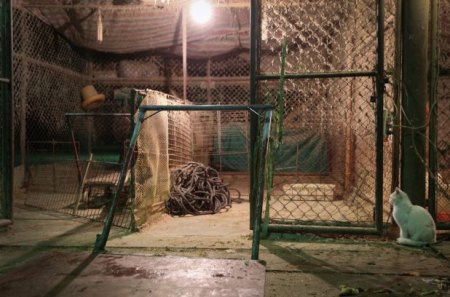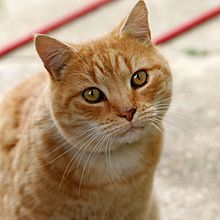Entries in influenza and infectious diseases (390)
A picture is worth a thousand words. Or nine lives. Or something like that.
The photo accompanaying today's Helen Branswell MetroNews/Canadian Press story regarding H7N9 avian influenza stuck out to me like a sore thumb.
Here's the photo. Can you tell what set me off?

If you said the cat, you'd be correct. Cats have a history with bird flu. In Indonesia, cats became such a worrisome vector that the government actually ordered the testing of cats. For the story, read my blog from 2007.
Also, in 2009, pH1N1 (the virus formerly known as swine flu) infected a housecat. Not in China; in Iowa. You can read my blog on that here. and the original Reuters story here. Wikipedia says:
Felidae (cats)
"In Bangkok, Thailand, all the cats in one household are known to have died of H5N1 in 2004. Tigers and leopards in Thai zoos also died, while in 2007 two cats near an outbreak in poultry and people in Iraq were confirmed to have died of H5N1, as were three German cats that ate wild birds. In Austria cats were infected but remained healthy". Cats in Indonesia were also found to have been infected with H5N1.[39]
The spread to more and more types and populations of birds and the ability of felidae (cats) to catch H5N1 from eating this natural prey means the creation of a reservoir for H5N1 in cats where the virus can adapt to mammals is one of the many possible pathways to a pandemic.
[edit] October 2004
Variants have been found in a number of domestic cats, leopards and tigers in Thailand, with high lethality.[40] "The Thailand Zoo tiger outbreak killed more than 140 tigers, causing health officials to make the decision to cull all the sick tigers in an effort to stop the zoo from becoming a reservoir for H5N1 influenza.[41][42] A study of domestic cats showed H5N1 virus infection by ingestion of infected poultry and also by contact with other infected cats (Kuiken et al., 2004)."[43] The initial OIE report reads: "the clinical manifestations began on 11 October 2004 with weakness, lethargy, respiratory distress and high fever (about 41-42 degrees Celsius). There was no response to any antibiotic treatment. Death occurred within three days following the onset of clinical signs with severe pulmonary lesions."[44]
[edit] February 28, 2006
A dead cat infected with the H5N1 bird flu virus was found in Germany.[45]
[edit] March 6, 2006
Hans Seitinger, the top agriculture official in the southern state of Styria, Austria announced that several still living cats in Styria have tested positive for H5N1:[46]
[edit] August 2006
It was announced in the August 2006 CDC EID journal that while literature describing HPAI H5N1 infection in cats had been limited to a subset of clade I viruses; a Qinghai-like virus (they are genetically distinct from other clade II viruses) killed up to five cats and 51 chickens from February 3 to February 5, 2006 in Grd Jotyar (~10 km north of Erbil City, Iraq). Two of the cats were available for examination.
- "An influenza A H5 virus was present in multiple organs in all species from the outbreak site in Grd Jotyar (Table). cDNA for sequencing was amplified directly from RNA extracts from pathologic materials without virus isolation. On the basis of sequence analysis of the full HA1 gene and 219 amino acids of the HA2 gene, the viruses from the goose and 1 cat from Grd Jotyar and from the person who died from Sarcapcarn (sequence derived from PCR amplification from first-passage egg material) are >99% identical at the nucleotide and amino acid levels (GenBank nos. DQ435200–02). Thus, no indication of virus adaptation to cats was found. The viruses from Iraq are most closely related to currently circulating Qinghai-like viruses, but when compared with A/bar-headed goose/Qinghai/65/2005 (H5N1) (GenBank no. DQ095622), they share only 97.4% identity at the nucleic acid level with 3 amino acid substitutions of unknown significance. On the other hand, the virus from the cat is only 93.4% identical to A/tiger/Thailand/CU-T4/2004(H5N1) (GenBank no. AY972539). These results are not surprising, given that these strains are representative of different clades (8,9). Sequencing of 1,349 bp of the N gene from cat 1 and the goose (to be submitted to GenBank) show identity at the amino acid level, and that the N genes of viruses infecting the cat and goose are >99% identical to that of A/bar-headed goose/Qinghai/65/2005(H5N1). These findings support the notion that cats may be broadly susceptible to circulating H5N1 viruses and thus may play a role in reassortment, antigenic drift, and transmission."[47]
[edit] January 24, 2007
"Chairul Anwar Nidom of Airlangga University in Surabaya, Indonesia, told journalists last week that he had taken blood samples from 500 stray cats near poultry markets in four areas of Java, including the capital, Jakarta, and one area in Sumatra, all of which have recently had outbreaks of H5N1 in poultry and people. Of these cats, 20% carried antibodies to H5N1. This does not mean that they were still carrying the virus, only that they had been infected - probably through eating birds that had H5N1. Many other cats that were infected are likely to have died from the resulting illness, so many more than 20% of the original cat populations may have acquired H5N1."[39]
Seeing a cat sitting outside an empty stall remined me immediately of these issues. Are the Chinese testing the cats? Are we seeing the death of cats in any significant number? Are the Chinese doing surveillance with veterinarians?
Cats eating wild birds is one thing. Cats eating diseased fowl in wet markets is another. Where are we more likely to see this?
H7N9 bird flu update: 24 confirmed cases, 7 deaths. And Zhong weighs in.
Today's count: There are now 24 confirmed cases of human H7N9, with seven deaths. ALl the cases and all the deaths remain in and around Shanghai and its immediately adjacent provinces.
Veteran flu blogger and noted author Crawford Killian has also posted a story regarding Zhong Nanshan. Zhong, if you have forgotten, became somewhat of a national hero in China m(and around the world, among medical experts) for his courageous stand against the status quo with SARS in 2003. He battled not just the virus, but inept local ChiCom government bureaucrats who stymied his initial attempts at transparency. I refer you to one of my 2008 blogs for background.
Zhong is arguing for a much larger surveillance effort than is currently underway. His remarks echo those of the Bill and Melinda Gates Foundation, which I covered last week.
From Crof's blog.
Zhong Nanshan, Chinese Academy of Engineering, said, "Analysis shows that the H7N9 virus comes from fowl, including poultry, wild fowl migrating birds and pigeons. We should expand the range of screening as not so many people have direct contact with poultry."
I wonder if Zhong means "not so many people (who contracted this virus) have direct contact with poultry."
Chinese hospital pays settlement with father of second bird flu death
Dr. Henry Niman may have stumbled onto something interesting. In his Recombinomics commentary of Saturday, he has identified a cash settlement from the hospital treating the first known H7N9 patients.
Dr. Niman cited an article from the South China Morning Post. Here's the headline and some copy:
Dead man's family claims bird flu cover-up by hospital
Wu Demao was bewildered when he heard that his son-in-law, Wu Liangliang, who died on March 10 at Shanghai No 5 People's Hospital, was a victim of H7N9 bird flu.
"No one has so far officially informed us of the true cause of his death," Wu said. "It was one of our relatives who told us that the local television had reported that my son-in-law died of a new strain of bird flu."
Wu Liangliang, 27, from Yancheng in Jiangsu, was the second man found to have caught H7N9 flu in Shanghai, the city government announced at a press conference on Tuesday, giving only his family name.
He arrived in Shanghai in February to visit his parents-in-law and helped Wu Demao, a pork vendor at a wet market on Jinggu Road in Minhang district.
Wu Liangliang suffered from high fever in late February and initial treatment by a nearby clinic and the No5 People's Hospital proved unsuccessful. He was admitted on March 1.
Doctors told the family he had pneumonia and he was not put into quarantine, Wu Demao said. (Bold mine)
The hospital paid the family 130,000 yuan (HK$161,000) in compensation on March 26, saying it was for humanitarian reasons and for its minor responsibility in Wu Liangliang's treatment, without elaborating.
As we call it in the good ol' U. S. of A.: This is a settlement. Or a payoff. Somehow, the hospital found it necessary to compensate the family for the young man's death.
Now why would the hospital proffer such an offer? Perhaps it is because they feel responsible for the young man's death. From Dr. Niman's commentary:
The above comments describe a payment to the family of the second H7N9 case (27M) who lived in the Minghang District and died at the Shanghai Number Five People’s Hospital in Minhang. The first confirmed case (87M) was also treated on the same floor of the hospital. In addition, his two sons (69M and 55M) were also treated at the hospital, so the family of the second victim claimed that their relative had been infected at the hospital by one of the three family members being treated at the hospital.
SARS was transmitted to unwitting patients via the HVAC systems in hospitals. This happened in both China and Toronto. Because they were in normal hospitals and not in negative-pressure isolation, the HVAC systems carried the virus to adjacent rooms -- and innocent patients who were there for unrelated reasons.
In other cases, SARS virus was carried by the medical personnel themselves, who were unaware that a novel coronavirius was being spread by their own interaction with patients.
It appears that the latter may have been the case here. The hospital, with its settlement, is inferring some culpability in the young man's death.
It also raises more questions about the route of transmissibility of this virus. We know influenza is transmissible from contact with contaminated solid surfaces. This unique case would seem to indicate that the virus can be spread by more than just inhaling a chicken or a pigeon. The young man was in a wet market, but working pork, not birds (hmmm...). Lord knows, a wet market has lots of opportunity for comtamination. trhat is why the Chinese have, basically, shut down all wet markets and eliminated the poultry and disinfected the markets.
Trouble in River City
 Ever since H7N9 was thrown at the world by the Chinese the night of March 31st, everyone familiar with events in China has wondered if there was truly any correlation between the sudden/whiplash emergence of this new flu substrain and the equally sudden and gut-wrenching sight of thousands of dead pigs floating down the Huangpu River.
Ever since H7N9 was thrown at the world by the Chinese the night of March 31st, everyone familiar with events in China has wondered if there was truly any correlation between the sudden/whiplash emergence of this new flu substrain and the equally sudden and gut-wrenching sight of thousands of dead pigs floating down the Huangpu River.
The Huangpu is the principal water supply for Shanaghai, as well as other areas. From Wikipedia:
Shanghai gets most of its drinking water from the Huangpu, and dumps most of its sewage into it (4 mln tonnes in 1990., only 4% of it treated in any way). As a result of pollution, the tap water must be heavily chlorinated.[2]
In February and March 2013, thousands of pig carcasses were found floating in the Huangpu River in Shanghai. Some of the pigs carried ear tags saying they were from Jiaxing, so that city in Zhejiang may be the source; however local farmers deny that.
Let us look at Apple Maps. Apple Maps has the Huangpu running through Cleveland. No! Dang that Apple Maps!
Let's look at a different source. The Huangpu is, by all accounts, a beautiful river. Regrettably, these days it has looked like this:
 The latest count has more than 20,000 dead pigs having been recovered from the Huangpu, many/most of them in and immediately around Shanghai.
The latest count has more than 20,000 dead pigs having been recovered from the Huangpu, many/most of them in and immediately around Shanghai.
It would be natural to speculate whether or not the pigs are the vector causing H7N9 to appear in humans. However, testing of roughly 34 carcasses has not revealed the presence of the virus.
Admittedly, a sample of 34 pig carcasses in a twenty-thousand carcass deluge is a small sample. However, it does appear that the two events are just coincidental.
From the British newspaper The Guardian:
This area of Zhejiang province, 60 miles from Shanghai, has become the subject of public and media scrutiny after more than 16,000 dead pigs were found in tributaries of the city's river, the Huangpu, a source of tapwater. As clean-up efforts wind down, mystery surrounds the cause of the pigs' demise and their appearance in the river.
As public concerns about water safety grow, what has emerged is a picture of a rural region marred by catastrophic environmental damage, inherent malpractice and a black market meat trade.
The first pigs were spotted on 7 March and were soon traced to Jiaxing through tags in their ears. Early tests show they carry porcine circovirus, a common disease among hogs not known to be infectious to humans. Shanghai's municipal water department maintains that the water meets the national standard, but hasn't said much more.
Again, the two events appear unrelated. However, the dates intersect with such similarity, and the provinces and cities are the same ones that are impacted by H7N9, that it is easily understood why the linkage would be there.
However, had the pigs been the vector, I have to think the Chinese Army would have exterminated and either buried or burned the pigs, and loudly proclaimed that the source of the infection was found and eradicated. they also would have found the presence of H7N9 in pigs upstream of Shanghai. In the Internet age,
The simple fact is that these events, however crazily coincidental, appear to be unrelated. However, I offer the possibly opposite view, by none other than Laurie Garrett. Laurie is well-known to infectious disease experts and readers of blogs. Her works have garnered her much distinction, and she is a Fellow at the Council on Foreign Relations (CFR). She was a consultant for the film COntagion and is highly-respected.
In Laurie's view, there is a possible connection between H7N9, the pig die-off (and she makes a very persuasive case for this), and the mass die-off of swans and ducks near Qinghai Lake. Qinghai is well-known to veteran flu followers: It is the origin of Clade 2.3 of H5N1 bird flu. It would not be a stretch to imagine Qinghai spawning yet another mutated bird flu. Laurie's excellent article can be found here.
In this fog of flu reporting, we will hear many things. Like most pandemics, and if H7N9 indeed becomes pandemic, the view will be in hindsight, via historians and researchers. But Laurie brings an interesting perspective to this puzzle.
Indeed, perhaps there are no coincidences here. Let's just hope that's all they are.
Interview with Dr. Michael Osterholm of CIDRAP on H7N9
Hat-tip to Valerie Mansuy of France for posting this link on Facebook. Mike is a great guy and one of the world's top infectious disease experts. You may recall his hour-long interview with Oprah in 2006 on H5N1 bird flu.

